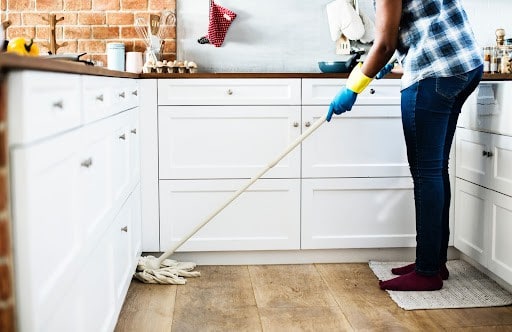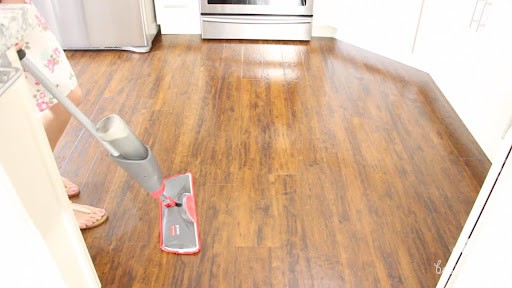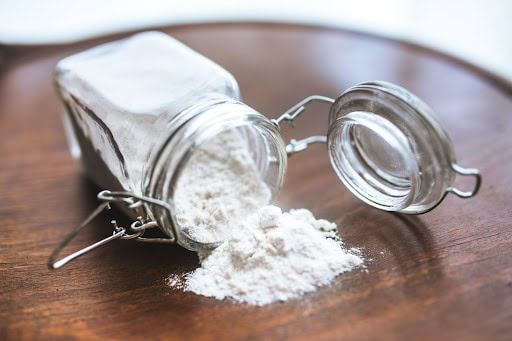You can clean sticky floors with common ingredients like white vinegar, sodium carbonate, and ammonia. You can also steam mop your floors with a commercial floor cleaner. Mild dish soap and baking soda can also help clean sticky floors.
No matter how hard you clean your floors, they always seem sticky!
That’s because you’re using the wrong cleaning product and the chemicals inside leave behind a residue. Stickiness can also appear if you use too much floor cleaning product or work with dirty water.
Below, I will explain why you always end up with sticky floors and provide 7 methods on how to clean sticky floors.
Why Is My Floor Sticky After Mopping?

Sticky floors will attract dirt much quicker and gather bacteria that can compromise your well-being. For instance, sticky bathroom floor tiles can result in mold and mildew, which is why you should clean your floors properly and frequently.
Using the Wrong Floor Cleaner
The most common reason for stickiness is using the wrong cleaning product.
Most normal cleaning needs include mild cleaning detergents, but when handling tough nasty stains, I can’t blame you for turning to harsher cleaning detergents like chemicals. And certain chemicals can leave a residue behind.
So, when dealing with tougher stains, don’t use harsh chemicals but focus on the stains. For instance, if you’re handling a sticky stain, use a detergent with the opposite pH (use acidic cleaners on alkaline dirt and the other way around).
If the chemical has a similar pH (acid or acid dirt), you will end up with sticky floors.
Using Too Much Cleaning Product
The second most common reason for sticky floors is using too much cleaning product.
Many people believe that using too much cleaning solution will leave their floors looking clean and smelling fresh.
The truth is the exact opposite. You will likely end up with sticky floors.
So, instead of using too much cleaning product, try to understand the type of your floor and check out the manufacturer’s cleaning recommendations.
Always use the proper measurements when cleaning your floor. Most cleaning products come with a measuring cup you can use to make sure you’re not using too much of the product.
Cleaning With Dirty Water
In my opinion, this is why most people end up with sticky floors. They don’t change the water at any point during their cleaning process. And this is a big mistake.
You see, dirty water already has residue and if you don’t change it often, you’re putting the residue back on the floor which can result in a dirty and sticky floor.
Therefore, the next time you clean your floor, change the water frequently and share in the comments if it’s still sticky at the end.
Not Rinsing The Floor Properly
Some people change the cleaning water frequently but forget to rinse their floor properly and still end up with a sticky floor.
Therefore, at the end of your cleaning journey, change the cleaning water one last time, then return to the starting point and rinse your floor with clean water.
Not Letting The Floor Dry
If you don’t let your floor dry completely and let yourself or your kids and pets walk over it while it’s still wet, the floor will get dirty again.
Also, any residue you or your kids and pets have on their feet will transfer onto the floor and make it sticky.
To prevent this from happening, you can either swipe your floor with a clean white towel after the cleaning process or open a window and let your floor air dry.
How To Clean Sticky Floors: 7 Methods

Youtube: https://www.youtube.com/watch?v=rzR2xuDSagg
If you’re dealing with sticky floors, choose one of the following 7 cleaning methods and enjoy a residue-free floor.
Method 1: Steam Mop
If you opt for this method, you will be using steam instead of detergent or bleach as you would with a regular mop.
In my opinion, it’s a very effective and time-saving method that will provide great results with tile and laminate flooring. The best part? A steam mop also works as a disinfectant. So, you will not only enjoy a clean but also germ-free floor.
The only downside of a steam mop is that it’s not suitable for cleaning all types of floors like wood or hardwood floors. Using a steam mop for cleaning wooden and hardwood floors can cause damage.
Method 2: White Vinegar
You can use white vinegar for cleaning wood and hardwood floors, laminate flooring, tile, and porcelain. It’s a gentle cleaner that doesn’t contain any corrosive properties.
White vinegar not only cleans but also disinfects and deodorizes floors. It’s also cheap and easily accessible.
To clean your floor with white vinegar, you will need a broom, a bucket of clean water, a mop, a sponge, a clean white towel, and of course, white vinegar.
First, sweep your floor with a broom. Then, mop off any residue as dust can leave stains throughout the cleaning process. Once you’re finished, mix 1 cup of white vinegar with 1 gallon of water. Then, rinse your floor with this solution.
Using a sponge scrub the floor’s surface until all the stickiness is gone. Rinse your floor with clean water and dry with a towel.
Method 3: Residue-Free Cleaner
Many household cleaners include dangerous foreign substances that can leave a sticky residue. Therefore, when buying a cleaning solution, opt for a residue-free one that can help you lift any dirt and stickiness. Then, use the cleaning solution as instructed on the packaging.
Method 4: Ammonia
Ammonia is a great degreaser!
You can use this affordable cleanser for cleaning tile floors. Mix 1 cup of ammonia with ½ gallon of plain water and clean your tile or vinyl floors with it. Let the solution sit for about 15 minutes. Then, mop it up with a clean sponge.
Keep in mind that ammonia contains corrosive properties. That’s why it’s so effective at cleaning. So, it’s suggested not to use it for regular cleaning. Instead, use it a few times throughout the year to remove residue build-up over a long period.
Extra tip: Never use ammonia for cleaning laminate flooring and hardwood and wooden floors. Furthermore, note that ammonia has a naturally strong smell, so it can leave your floor smelling like it for a while.
If this isn’t a deal-breaker for you, go ahead and use ammonia today!
Method 5: Baking Soda

Baking soda is a mild but effective detergent that can help remove stickiness from your floors without causing any damage.
Mix ½ cup of baking soda in a bucket of lukewarm water. Or hot water if you’re handling a very sticky floor. Use the mixture to mop your floors. Then, rinse with clean water. You will end up with a clean, fresh-smelling floor.
Some people even mix baking soda with vinegar cleaners for even better results.
Method 6: Alkaline Cleaner
Sodium carbonate, also known as soda ash or washing soda, is a great cleaning agent that softens the water.
Therefore, it’s also very effective at removing stickiness from wood floors. Or any other type of floor for that matter.
This alkaline cleaner has a pH of 11. It’s also safe for the environment, so you can use it for cleaning your floors at any time.
Method 7: Mild Dishwashing Soap
You can use dishwashing soap or another mild detergent as a floor cleaner. Mix 1-2 tablespoons of dishwashing soap with a bucket of water.
Moreover, use the measuring cup to get the right measurements and make sure you’re not using too much of the product.
Once you’re done mixing the ingredients, use it to give your floor a deep clean. Make sure you’re changing the water frequently so you don’t end up with a sticky floor again.
To complete the cleaning process properly, watch out for all the sticky parts of your floor, rinse the floor after every part, and wring your mop or sponge as often as you can.
You can use dishwashing soap or other detergents on tile and vinyl floors. Avoid using dishwashing soap on wooden floors as they can get stained by moisture.
FAQs On How To Clean Sticky Floors
Does Vinegar Make Floors Sticky?
Vinegar doesn’t make floors sticky. On the contrary, it’s a great floor cleaner. You can use vinegar and water to clean sticky floors and end up with a clean disinfected floor. You can also use baking soda and vinegar for even better results.
Can I Use Isopropyl Alcohol To Clean Floors?
Isopropyl alcohol can clean grease. You can use it to remove any sticky substances or stains from your floor. The best part? It’s drying fast, so you don’t have to wait for your floor to dry before you step on it after the cleaning process.
Can You Mop With Acetone?
Acetone is a solvent. In other words, it can break down organic substances like grease, glue, paint, etc. But you shouldn’t use it to mop your floors as it can cause damage to the finish. Instead, use it to remove greasy or sticky stains.